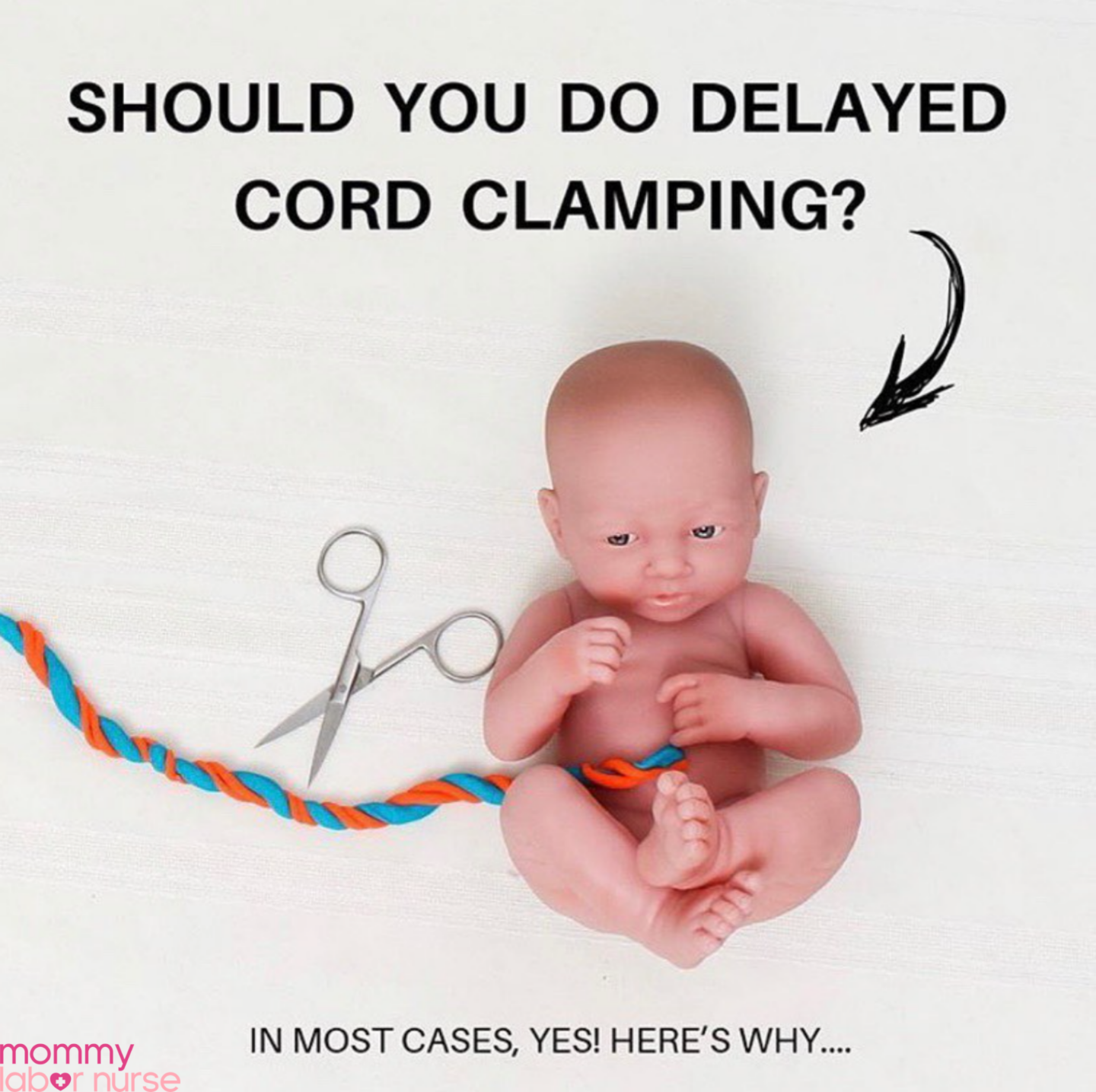Are you wondering what happens during delivery? And what happens right after birth?
Well, mama, you are in the right place. So much attention is given to the labor part of birth (and for good reason – it is the longest after all!).
But this article is going to focus totally on the rest of the birth process.
In fact, birth has four stages, and we’re going to talk all about stages 2-4: pushing, delivering the placenta, and the immediate hours postpartum.
I want you to have an understanding of the ENTIRE experience in order to be fully prepared for this life-changing event!
So let’s get to it and find out exactly what happens after birth and during delivery.
Follow @mommy.labornurse on Instagram to join our community of over 650k for education, tips, and solidarity on all things pregnancy, birth, and postpartum!
What happens during delivery: pushing out a baby
After hours (and sometimes days) of labor, you’re finally 10 centimeters dilated! Giving birth is extremely overwhelming, and I’m here to walk you through it from my eyes as a labor and delivery nurse!
So, once you’ve reached 10 cm you’re officially in the second stage of labor. This is better know as the pushing stage. This stage lasts right up until baby makes their appearance into the world.
Related Reading: Preventing Tearing During Birth
How long will I push for?
If this is your first baby, you may need to push for a little while before we meet your lovely bundle of joy. An average push time for a first time mom is 2 hours.
WHAT?!
I know, that sounds like forever. The reality is, your body has never had something as big as a baby pass through your vagina before, and it just takes some time for baby to squeeze through your pelvis.
This is an average though, and some patients only push ONCE (and then I deliver your baby instead of the doctor/midwife!!)
No worries though, your labor nurse will be there with you for every push! Usually, I tend to push with a patient until the top of baby’s head comes underneath your pubic bone, and stays there. AKA, you’re crowning.
Once you’ve pushed baby down far enough to where I feel like it’s appropriate to call your doctor or midwife, A WHOLE LOTTA STUFF GOES ON.
Related Reading: One Benefit of Prenatal Fitness is a Shorter Push Time!
In comes your provider and support staff
I begin by calling your doctor/midwife and a few extra nurses to your room.
Generally, if there are no complications we are aware of at the time, I would call my charge nurse and a newborn specialist to take care of baby once you deliver.
Usually, a scrub tech (nurse aide) will come to your room as well if available.
How does the support staff help?
My charge nurse is there to help with any extra computer charting, offer an extra set of hands for those last few pushes, and for moral support. She is also there to assist in case an emergency arises.
The newborn specialist is present to do just that, take care of baby! She is usually designated to assign APGARs, dry and stimulate baby, suction baby, and get baby skin-to-skin if able.

Although, I am fully able to assume this role if there is no baby nurse available at the time. All L&D nurses are trained in neonatal resuscitation immediately after birth, so no worries there!
During the next hour, the newborn specialist will be performing a head to toe assessment of baby, getting frequent vital signs, and doing baby’s measurements. She will also give baby a vitamin K shot and an antibiotic eye ointment. Both of these are optional, and can be done at a later time if you wish.
Related Reading: Wanna Learn More About Labor And Delivery, But Don’t Know Where to Start?
What happens immediately after birth?
Delayed cord clamping

Nowadays, most hospitals will do delayed cord clamping for at least one minute, unless baby comes out and needs immediate intervention. This has come into standard practice, which is great!
After the cord has been clamped, your partner (or whomever you choose) can cut the umbilical cord, and you can begin immediate skin to skin with baby.
Delivering the placenta
At this point, you still have half of an umbilical cord hanging out of you, and an entire placenta still inside that needs to come out.
Generally, the placenta detaches on its own, and you will deliver it in the next 5-10 minutes after baby. Sometimes taking up to 30 minutes.
The placenta doesn’t hurt nearly as terribly as baby coming out, but it’s still not awesome. It’s basically like giving birth to a huge mound of Jell-O.
Uterus contracting back down
After the placenta is delivered, your doctor/midwife will be performing fundal pressure. This is done to assess how your bleeding is, and if your uterus is firm and acting the way it should after delivery:
When you are pregnant, the capacity of your uterus expands to over 500 times larger than it was pre-pregnancy! After it expels baby and placenta, it’s still pretty stretched out.
Given that it’s a huge muscle, its primary job after delivery is to contract and shrink down to its pre-pregnant size. This is a process, (it takes about 6 weeks to shrink completely), but it begins immediately after birth.
It’s important for it to be doing its job, because if it’s not shrinking down effectively, you can have a whoooole lot of extra bleeding and it can actually be super dangerous.
In fact, this is the #1 way woman used to die in childbirth. Luckily we’ve made a lot of advancements since then, and birth mortality is at an all time low in the world.
Bonding with baby in the first hour after birth
As long as baby didn’t need any special attention or care immediately after birth, you will be able to bond with baby while all of this is going down.
In fact, most newborn care procedures can be delayed in favor of one hour of uninterrupted bonding, skin to skin care, and initiated breastfeeding right after birth.
This is known as the golden hour and carries SO many benefits for mama and baby including:
- Baby initiation of breastfeeding (which may be associated with greater breastfeeding success)
- Lower infant mortality rates
- Regulation of body systems for mama and baby
- Boost to baby’s immune function
- Helps to deliver the placenta and contract the uterus
Related Reading: Breastfeeding Tips Before You Start
A little more about managing bleeding right after birth
So, now that your placenta is out, I’m going to be doing a few things to make sure we don’t have all that scary bleeding!
You’re going to have SOME bleeding (in fact you’re probably going to think it’s a lot), but my PRIMARY job right now is to make sure it stays under control.
If your uterus isn’t contracting well on its own (sometimes called a lazy uterus), there are some steps I’ll be taking to monitor your progress and keep you safe. It’s super important that you don’t lose too much blood!
You’ll likely get Pitocin
One thing I might do is give you Pitocin (Oxytocin) through your IV. This is the same Pitocin you had during labor if you were induced, I just give you a heck of a lot more.
Pitocin helps to make sure your uterus is doing its job of contracting down. Although don’t worry these uterine “contractions” don’t hurt the same way that they did during labor!
Fundal massage
The other thing I’ll definitely do is give you a massage!! A FUNDAL massage. Even though they contain the word FUN, there is nothing fun about them.
Fundal massage consists of me pressing HARD on your stomach, to make sure your uterus is in the right area and that it’s nice and firm.
Unfortunately, I need to do these massages every 15 minutes for the next 2 hours while you are still in L&D. Once you transfer to postpartum, your nurse will perform them much less frequently.
Once your doctor/midwife feels your bleeding is controlled right after delivery, he/she will leave and we will get you cleaned up.
Moving into your postpartum recovery room and the rest of your hospital stay
Once your provider leaves, you’ll be able to eat, recover a bit, and let your family in to see you and baby. At this point, you will still be in the labor and delivery room
You will stay here for approximately 2 hours before heading to a postpartum room. Some hospitals keep you in the same room for your entire stay. Either way, after 2 hours, we will bother you a lot less!
Related Reading: Postpartum Recovery Tips
Now you know what happens after birth

I hope I’ve given you a glimpse into what’s to come! There is SO much info to process about when you come to have your baby. I know it can be very daunting and outright confusing at times.
That’s one of the reasons I try to break the information down into smaller parts of the bigger birth experience. Here are some more articles to help you prepare:
- Labor Tips for First Time Moms
- Epidurals Explained
- The BEST Natural Birth Tips
- Postpartum Essentials
Just know that as your labor nurse, I always have your best interests at heart. I am your advocate, and I’ll always be on your side. With that said, here’s to a happy and healthy delivery!





